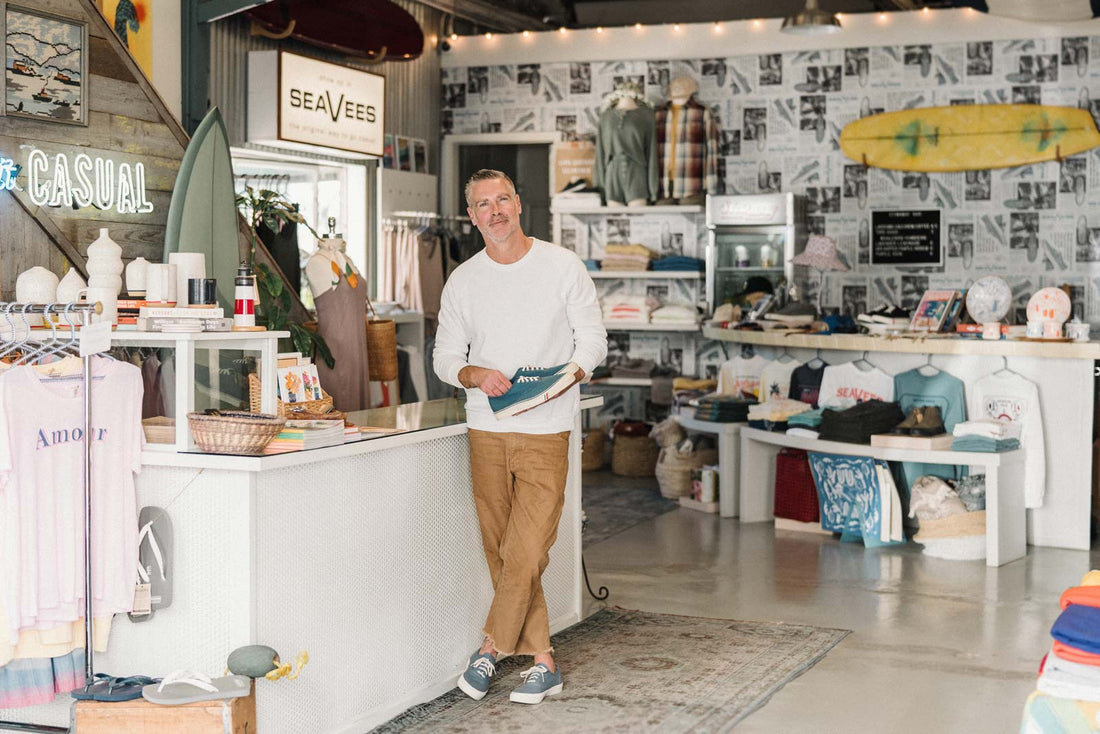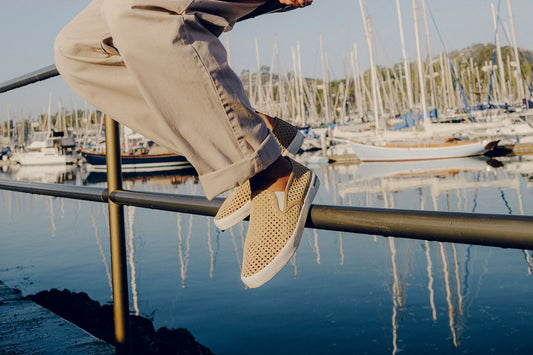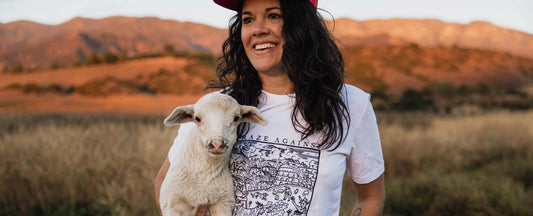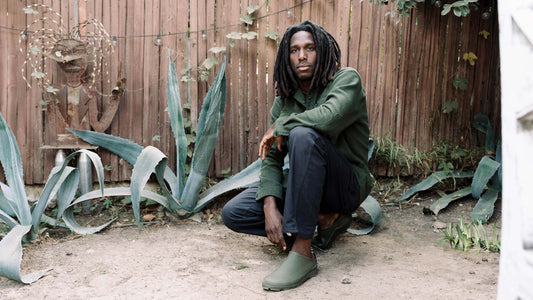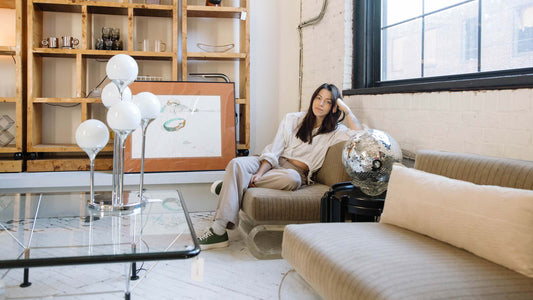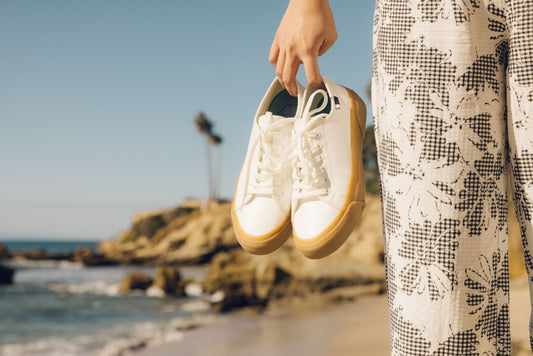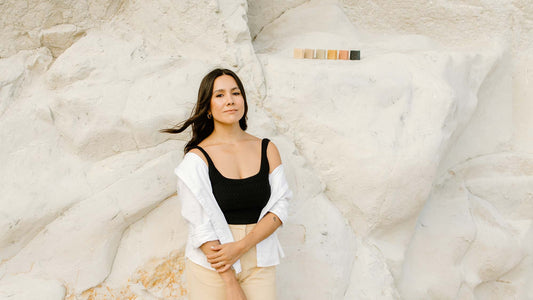When construction was underway at the flagship SeaVees retail shop in Santa Barbara’s Funk Zone, Steven Tiller would sit in the corner on a wooden plank suspended between two orange buckets, dreaming about the future space. The buckets have long since been replaced by a bench, but it’s still the first place the company’s founder gravitates toward in the shop.
Old habits die hard. Growing up, Steven made one out of collecting trading cards, classic novels and, eventually, artifacts of the California culture he emulated as a kid. He couldn’t have known it then, but his penchant for collecting what others have tossed off or forgotten would lead to his most significant thrift shop find — one that would help him rediscover a dream at age 40 he’d nearly lost sight of.
As told to SeaVees. Photography by Johnie Gall.


“Everything changed in the fifth grade when this kid named Tony moved in from California. We were growing up in Oklahoma and here comes Tony on his skateboard with long, sun-bleached hair and OP corduroy shorts. He didn’t talk or dress like any of us kids, and we were instantly mesmerized. My friends and I started following him around and we became this little land-locked wannabe surf club, entering skateboarding competitions and lip-syncing to the Beach Boys. That was the first call to California that I can remember feeling. It became this intense longing to live there that I’d carry with me through my life.

I learned the value of a dollar and hard work at a young age. My grandparents oversaw concessions at University of Oklahoma football games when I was a kid, so my first job was selling Coca-Cola at the stadium when I was 11 years old. The older guys could carry two trays but I was so small I could only handle one at a time while yelling at people to get their ‘ice-cold Coke!’ Everyone in my family worked hard and that wasn’t lost on me. It became fuel. Not having a lot taught me to appreciate what I did have. It was a gift because it gave me drive and determination that continues to motivate and inspire me to work hard.
“To an outsider, I must have looked successful, but inside all I could think was that I was most successful at not being true to myself.”
Moving to California for college would have been a dream, but it just wasn’t an option for me at that time in my life. But I knew I wanted to experience more of the world beyond my small town. So I put school on hold and began traveling around the world when I was 19 as a fashion model — I knew modeling wasn’t something I wanted to do with the rest of my life, but I saw the value in what it might mean to get to explore new places and see new things I might not otherwise have the chance to. Always being on the road at that age could be a lonely experience, so I began reading as a way to stay busy and to continue my education. I challenged myself to read 100 books a year and they all had to be classics. I dove into Jack Kerouac, Ernest Hemingway, O. Henry, F. Scott Fitzgerald. The books were dog-earred and underlined and I kept all of them because I’ve always been into collecting things: novels, albums, trading cards. I’m fascinated by what makes certain things endure and stand the test of time.


I made this master plan to start my career in fashion at the footwear company Cole Haan in Maine, learn from the best, and then take my entrepreneurial spirit and start something of my own on the West Coast. But that isn’t what happened, at least not right away. Eighteen years later I was still on the East Coast, always being recruited away to the next job, the next city, on this self-imposed fast track to the top as a global trendspotter. To an outsider, I must have looked successful, but inside all I could think was that I was most successful at not being true to myself. My longing for starting a company of my own turned into an active yearning that gnawed at my gut: Why don’t you? Why haven’t you? Are you ever going to? It continued to haunt me as I got older and had a family, moving further and further away from my dream.
I had a big bag of shoes in my basement that I had been collecting. I called it my ‘Someday’ bag. While traveling to fashion capitals around the world for work, I’d use my free time to visit street markets and thrift shops and I would buy old sneakers — Converse from the ‘60s, Vans from the ‘70s, original Adidas and Puma sneakers, and other heritage brands you’ve never heard of. I don’t even know why I was doing it, but I knew if I ever found the courage to start my own company it wouldn’t be a new brand. I had this deep-rooted desire to find a shoe style that had a soul and a past, something that was made before shoes were mass-produced. When I found the first pair of SeaVees in a secondhand shop in Tokyo, Japan, it was this great collision of the things I was passionate about: sneakers, history, California, fashion. I mean, the word ‘sea’ was in the name. When I found that shoe, I found myself for the first time.


On the flight home from Tokyo, I kept telling myself to calm down because I didn’t want to land feeling totally on fire only to discover the brand wasn’t available. I didn’t want to get my heart broken. I hired an attorney, found out that any rights to the brand had been abandoned for decades, filed the papers, waited 18 months, and got global ownership of the SeaVees brand. Then it became about convincing the factories to make the shoes, the retailers to carry them. It feels impossible at first, and then little by little things start moving. The dream suddenly starts to work and as long as you have these little crumbs of encouragement, you don’t give up on it.
“I remember questioning why I hadn’t done this when I was 22 and sleeping on a friend’s couch eating cereal for dinner with nothing to lose.”
There used to be this store called Jeffery’s in New York’s Meatpacking District that was the spot, run by this visionary merchant. I went in with no shoes, just an old advertisement for SeaVees, and convinced the buyer to take a chance on my product — I immediately emailed all my friends and told them I’d be judged on how our product sold that first week. The shoes hit on a Wednesday and I drove down from Boston on a Saturday with my family to visit the shop. A sales associate looked at me and said, ‘I don’t know what’s going on but your shoes are just flying off the shelves.’ I looked behind the cash wrap and saw boxes of shoes ready to ship out — they were all orders from my friends. It took that spark to ignite something and suddenly people wanted in. Shortly thereafter, there were orders from Bergdorf Goodman, then Barney’s, then Bloomingdales. I’m making it sound serendipitous [laughs]. It took a lot of work, but also support from my community and, ultimately, luck.

I wasn’t a kid anymore — I was nearly 40 by then with a family and a home. When you’re young, you don’t know what you don’t know and you have this unearned sense of courage. I remember questioning why I hadn’t done this when I was 22 and sleeping on a friend’s couch eating cereal for dinner with nothing to lose. But I also remember thinking that I either had to prove it to myself I could do this — or that I couldn’t. When I told my wife my idea, she looked at me and said, ‘I know you. You have to do this and get it out of your system. If you don’t, you’re going to look back with so much regret, and I’ll still be here, and I’ll have to hear about it. And that’s going to kill both of us.”
I live in California now. One of the most famous men on the planet, Brad Pitt, wears our shoes almost everyday. We just opened our third retail store. I realize I’m living my dream, but dreams aren’t perfect. On the good days, the highs are so incredibly high in a way I don’t think I ever felt working for someone else. But the lows are devastating in a way I certainly never felt working for someone else. I’m 14 years into this and in some ways I feel like I’ve just started. The mistakes I made on this journey are mind-blowing — but I can’t even fathom the kind of mistakes I would have made had I been in my 20s. I’m over 30 years into my career and I’ve never had more experience than I do right now, yet I’ve never valued that experience less. I approach every single day like a student, not a teacher because I’m curious what I can learn. Curiosity is such a huge part of being an entrepreneur, you just have to have it. I still fail all the time — it’s the most human thing we can do.


Everyone has dreams, but going after them might not be for everyone. When you pursue a dream, the road behind you will be littered with loss. You’ll lose relationships, money, things that matter to you. You have to embrace failure and have a lot of courage and commitment to see it through when everyone is telling you it won’t work. I think you know if it’s in you or not. But you have to be all in.
“I think the most important part of having an entrepreneurial spirit is being stubborn enough to have a vision that no one else can see.”
My dad was a mailman, the longest tenured postal service employee in Oklahoma state history, and he’s always been my biggest role model — I wanted to be just like him. He always told me I had a type of ambition that he just didn’t have, but I admired him for his sense of contentment about life. He was so committed to our family and to his job, yet he managed to never bring that work home with him. I don’t know if that’s part of my shared DNA [laughs]. I have a restless spirit, but I’m happy that way — it’s in my nature. Dad once asked me what I think about retirement, and I told him I’d be miserable if I ever stopped what I’m doing because I have the gift of getting to do what I love every single day. And I have a lot left to do in pursuit of my dream.
I never wanted my name on a brand. If I do this right, then I might end up as just a footnote in SeaVees’ history — and I hope it’s because I was a thoughtful steward of the brand during this chapter. I think the most important part of having an entrepreneurial spirit is being stubborn enough to have a vision that no one else can see, and my vision is for people to know SeaVees the way they know legendary brands like Ray-Ban and Levi’s. I want to create something that will endure, that will stand the test of time, like those old classic books or Beach Boys records. I don’t just want to capture a moment, I want to create a legacy.”
Steven is wearing the Men's Legend Sneaker.

